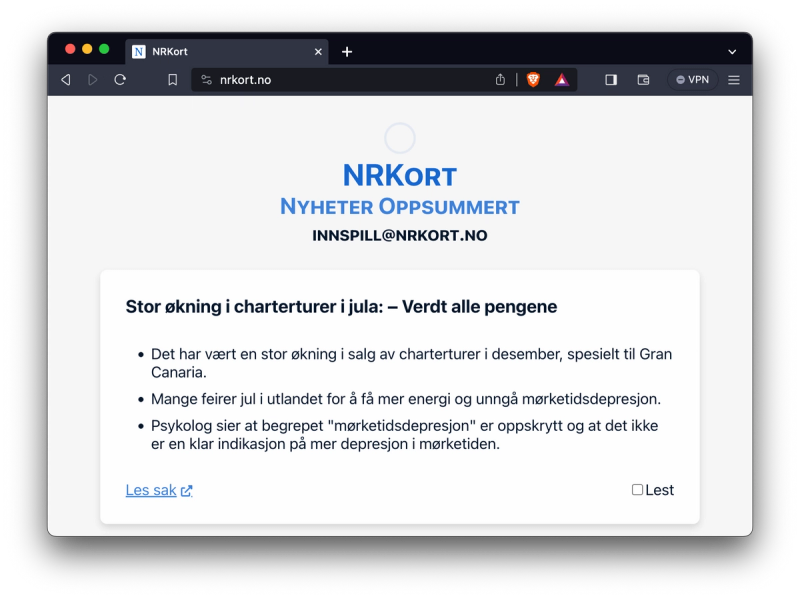Behind NRKort: Using AI to Summarize the News
How much time do you spend reading the news?
In a day? A month? A year? A decade?
4 min read
·
By Simon Foldvik
·
December 24, 2023
…and what if you could read the same news, just faster?
Welcome to NRKort!
About NRKort
NRKort is a service summarizing the news from the main Norwegian news provider, NRK. Every ten minutes, the front page of NRK is scanned for new articles, which are consecutively fed into a large language model instructed to extract only the most important factual points. The result is a three-point synopsis of each article along with its heading.

This process increases the information density by reducing chatter, allowing the user to first read a synopsis of the subject at hand before deciding whether or not to invest the time to read the full article.
This puts the cost of reading up front: The user does not actually have to read or scan large parts of the full article in order to decide whether or not it would be interesting to read, saving both time and cognitive bandwidth.
The name 'NRKort' is a wordplay which only works out in Norwegian: Its first constituent 'NRK' is the name of the originating news provider; the second part, 'Kort', means both card and short in Norwegian, signifying the essence of having NRK news presented briefly through synoptic cards.
NRKort is to the best of the author's knowledge the first and only service of its kind in Norway.
Statistics
Monthly Visitors
NRKort was launched in late August 2023 and averages around 500 unique visitors every month, depending on which data is taken into account.
To be specific, here is the number of unique visitors per month since its launch in August 2023:
- August: 502
- September: 890
- October: 461
- November: 496
- December: 333 (as of December 24th)
Summaries Posted
Counting from September, a total of 4204 summary cards have been posted on NRKort, with an average of 37 new cards being added every day. This averages out to approximately 1115 unique summaries being posted every month.
Here is a breakdown of the number of summaries posted per month:
- September: 1138
- October: 1100
- November: 1124
- December: 842 (as of December 24th)
The Question of Copyright
The obvious question to ask is whether AI summaries, such as the ones provided by NRKort, are copyright infringements or fair use. Evidence for the latter is a citation of the original source (URL), displayed on every card.
The author has contacted NRK on several occasions, but has as of this writing not succeeded in getting an official statement from NRK on these matters.
A New Take on AI Journalism
Instead of humans writing about AI, we might have AI writing about humans.
At this point, one would not have had to expend much effort to cross paths with AI journalism – rather the opposite. AI journalism entails human authors writing about the latest innovations and trends within AI.
It is not far-fetched to imagine that the tables may turn: AI writing about the latest trends and fashions concerning humans.
Picture this: The events of the world are serialized into subscribable data streams past the threshold that it only remains to parse out what has actually happened since, e.g., yesterday or the past hour.
With access to such data streams, there would no longer be a need for humans to digest and present the news from the source material: Large language models could do that.
There of course remains the problem of gathering said data to begin with, but as far as the writing process goes, the benefits from the point of view of productivity are obvious:
- Humans are out of the loop, thus reducing costs and time spent writing.
- News can be generated on demand and in a voice or persona appropriate for the given context.
- News consumption may be tuned more factual with less chatter, making it possible to stay updated in less time.
Perhaps only the human reporter will remain, in its literal sense, feeding our AI systems with the data it needs to satiate our news delivery demands.
Up next...
Loading…